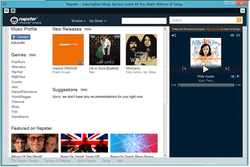Napster (pay service)
 | |
| Subsidiary | |
| Industry | Online Music |
| Founded | 1999 as free (and reconfigured as non-free by Roxio in 2003) |
| Headquarters | Los Angeles, California, United States |
Key people | Mike Davis, CEO[1] |
| Products |
Napster Napster to Go Napster MP3 Store |
| Revenue |
|
|
| |
Number of employees | 138 (2007) |
| Parent | Rhapsody International Inc. |
| Website | www.napster.com |
Napster is an online music store and a Rhapsody company, branded under the purchased name and trademarks of former free file sharing service Napster.
History
|
Napster 5.0 beta | |
| Developer(s) | Napster, Inc. |
|---|---|
| Stable release |
4.6.3.4
/ August 31, 2010 |
| Preview release |
5.0
/ 2012 |
| Operating system | Microsoft Windows, Mac OS X, Linux Wii U |
| Type | Media player |
| License | DRM-free MP3, WMA |
| Website | Napster.com |
The company's name and logo originated from bankruptcy liquidation of the Napster peer-to-peer file trading service,[2] which was shut down after a series of legal actions taken by the RIAA. The brand name was later purchased by Roxio, to capitalize on the popularity of the former service. Napster was later acquired by Best Buy. The service merged with Rhapsody in 2011.
As a Roxio subsidiary
Roxio bought the assets of the original Napster company at its bankruptcy auction in 2002 and the online music service called pressplay in 2003, with the intention of using these assets as the basis of a new legal online music service which would let users access music through a subscription or on a fee-per-song basis. Roxio spent years revamping the company as a non-free online music service. This involved a great deal of management re-organization and the start of a new business model. Roxio spent years developing a network of business partners and relationships to ensure success for their new enterprise.[3][4][5][6][7][8][9][10][11] [12][13][14][15]
In May 2006, Napster launched Free Napster (via the URL http://Free.Napster.com/) but this service was discontinued in March 2010. It was a free, advertising-supported Web experience which enabled music fans in the USA to stream full-length versions of all the songs in Napster's catalog of over 8 million tracks three times each, without downloading any software or making any service commitment. Visitors could also purchase DRM-free MP3 downloads.
As a Best Buy company
Napster was formerly headed by Chris Gorog who served as Chairman and CEO, Bradford D. Duea who served as President and Christopher Allen who served as Chief Operating Officer. On January 6, 2010, Gorog and Duea stepped down from their positions. In an interview, Gorog stated that "After we understood the approach Best Buy was taking with Napster, it became clear the company didn't need a CEO, a president and a COO going forward".[16] Allen assumed the position of "General Manager," reporting to Chris Homeister, Best Buy's senior vice president of merchandising entertainment.[17][18]
Purchase by Rhapsody
The company was acquired by Rhapsody, another streaming and download service, in 2011. On July 14, 2016, Rhapsody formally changed its name to Napster, joining the 33 countries where it already operated as Napster to form one global brand. http://blog.napster.com/2016/07/14/wearenapster/
Services
Napster, the basic subscription tier, offers unlimited listening for $5–7 per month (£10 per month in the UK). USA members may also purchase DRM-free MP3 downloads at a discount. Napster also offers an MP3 store, a pay-per-track store which does not require a monthly subscription fee.
Napster To Go, the company's portable subscription tier, allowed unlimited transfer of music for $8–10 per month (£8 per month in the UK) This service was discontinued after the takeover by Rhapsody.
Napster's mobile music service Napster Mobile enables users to search and browse Napster’s music catalog and preview, purchase and play songs on their mobile handset through an integrated music player.
See also
- Windows Media Player
- Streaming media
- DRM
- Online music store
- MusicStation
- Comparison of media players
References
- ↑ Napster: Napster Management.
- ↑ "Porno company offers to buy Napster". CNET News.com. September 12, 2002.
- ↑ ^ Penn State and Napster team up to make legal tunes available to students
- ↑ ^ FairUse4WM strips Windows Media DRM!
- ↑ ^ /How To Steal Music..... Sort Of
- ↑ ^ Audio extravaganza!
- ↑ ^ Do the Math advertisement
- ↑ ^ TMO reports
- ↑ ^ As of January 18, 2006. See press release
- ↑ ^ As of the 2006 fiscal year, the last year Real broke out dedicated Rhapsody subscriber numbers.
- ↑ ^ Vance, Ashlee (November 7, 2003). "Penn State students revolt against Napster, DRM invasion". The Register.
- ↑ ^ Napster, Inc (July 19, 2004). Global Napster Expands University Program with the Addition of Six Schools. Press Release.
- ↑ ^ Viega, Alex (January 25, 2006). "Napster denies rumors of trouble amid layoffs". San Jose Mercury News.
- ↑ ^ White, Michael (September 18, 2006). "Napster Hires UBS to Evaluate Possible Company Sale". Bloomberg.
- ↑ ^ Hessaldahl, Arik (September 19, 2006). "A Needy Napster Searches for Takers". Business Week.
- ↑ Q&A: Napster ex-CEO Chris Gorog by Antony Bruno, January 19, 2010
- ↑ Former Napster CEO’s “Dream” More of a Nightmare When You Really Think About It by John Paczkowski, January 6, 2010
- ↑ ^ Dignan, Larry (September 15, 2008). "Best Buy acquires Napster; Eyes digital music distribution".
